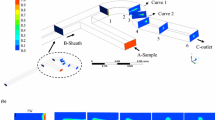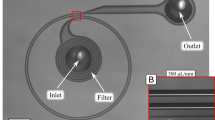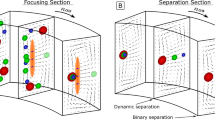Abstract
Even at low Reynolds numbers, momentum can impact the shape of hydrodynamically focused flow. Both theoretical and experimental characterization of hydrodynamic focusing in microchannels at Reynolds numbers ≤25 revealed the important parameters that affect the shape of the focused layer. A series of symmetric and asymmetric microfluidic channels with two converging streams were fabricated with different angles of confluence at the junction. The channels were used to study the characteristics of Y-type microchannels for flow-focusing. Computational analysis and experimental results gathered using confocal microscopy and particle image velocimetry indicated that the orientation of the sheath and the sample stream inlets, as well as the absolute flow velocities, determine the curvature in the concentration distribution of the focused stream. Decreasing the angle of confluence between sheath and sample, as well as reducing the overall Reynolds number, resulted in a flat interface between sheath and focused fluids. Alignment of the faster flowing sheath fluid channel with the main channel also reduced the inertial effects and produced a focused stream with a flat concentration profile. Control over the shape of the focused stream is important in many biosensors and lab-on-a-chip devices that rely on hydrodynamic focusing for increased detection sensitivity.






Similar content being viewed by others
References
Anna SL, Bontoux N, Stone HA (2003) Formation of dispersions using “flow focusing” in microchannels. Appl Phys Lett 82:364
Atencia J, Beebe DJ (2005) Controlled microfluidic interfaces. Nature 437(7059):648–655
Ben-Tzvi P, Rone W (2010) Microdroplet generation in gaseous and liquid environments. Microsyst Technol 16(3):333–356
Brody JP, Yager P, Goldstein RE, Austin RH (1996) Biotechnology at low Reynolds numbers. Biophys J 71(6):3430–3441
Choi Y-S, Seo K-W, Lee S-J (2011) Lateral and cross-lateral focusing of spherical particles in a square microchannel. Lab Chip 11(3):460–465
Culbertson CT, Jacobson SC, Michael Ramsey J (2002) Diffusion coefficient measurements in microfluidic devices. Talanta 56(2):365–373
de Mello AJ, Edel JB (2007) Hydrodynamic focusing in microstructures: improved detection efficiencies in subfemtoliter probe volumes. J Appl Phys 101:084903–084908
Di Carlo D (2009) Inertial microfluidics. Lab Chip 9(21):3038–3046
Fick A (1855) On liquid diffusion. Philos Mag Ser 4 10(63):30–39
Fujisawa N, Nakamura Y, Matsuura F, Sato Y (2006) Pressure field evaluation in microchannel junction flows through PIV measurement. Microfluid Nanofluid 2(5):447–453
Gobby D, Angeli P, Gavriilidis A (2001) Mixing characteristics of T-type microfluidic mixers. J Micromech Microeng 11(2):126–132
Golden JP, Kim JS, Erickson JS, Hilliard LR, Howell PB, Anderson GP, Nasir M, Ligler FS (2009) Multi-wavelength microflow cytometer using groove-generated sheath flow. Lab Chip 9(13):1942
Hairer G, Vellekoop MJ (2009) An integrated flow-cell for full sample stream control. Microfluid Nanofluid 7(5):647–658
Hatch A, Kamholz AE, Hawkins KR, Munson MS, Schilling EA, Weigl BH, Yager P (2001) A rapid diffusion immunoassay in a T-sensor. Nat Biotechnol 19:461–465
Hofmann O, Voirin G, Niedermann P, Manz A (2002) Three-dimensional microfluidic confinement for efficient sample delivery to biosensor surfaces. Application to immunoassays on planar optical waveguides. Anal Chem 74(20):5243–5250
Howell PB, Mott DR, Golden JP, Ligler FS (2004) Design and evaluation of a Dean vortex-based micromixer. Lab Chip 4(6):663–669
Hua SZ, Pennell T (2009) A microfluidic chip for real-time studies of the volume of single cells. Lab Chip 9(2):251–256
Huh D, Gu W, Kamotani Y, Grotberg JB, Takayama S (2005) Microfluidics for flow cytometric analysis of cells and particles. Physiol Meas 26(3):73–98
Ismagilov RF, Stroock AD, Kenis PJA, Whitesides G, Stone HA (2000) Experimental and theoretical scaling laws for transverse diffusive broadening in two-phase laminar flows in microchannels. Appl Phys Lett 76:2376–2377
Kamholz AE, Weigl BH, Finlayson BA, Yager P (1999) Quantitative analysis of molecular interaction in a microfluidic channel: the T-sensor. Anal Chem 71(23):5340–5347
Kenis PJA, Ismagilov RF, Whitesides GM (1999) Microfabrication inside capillaries using multiphase laminar flow patterning. Science 285(5424):83–85
Kim YT, Pekkan K, Messner WC, LeDuc PR (2010) Three-dimensional chemical profile manipulation using two-dimensional autonomous microfluidic control. J Am Chem Soc 132(4):1339–1347
Leatzow DM, Dodson JM, Golden JP, Ligler FS (2002) Attachment of plastic fluidic components to glass sensing surfaces. Biosens Bioelectron 17(1–2):105–110
Lee GB, Chang CC, Huang SB, Yang RJ (2006) The hydrodynamic focusing effect inside rectangular microchannels. J Micromech Microeng 16(5):1024–1032
Liu J, Oran E, Kaplan C, Mott D (2007) FCT and Direct Pressure Evaluation for Incompressible Flows. In: 45th AIAA aerospace sciences meeting and exhibit, Reno, Nevada, 2007, p 319
Mott DR, Howell Jr PB, Golden JP, Kaplan CR, Ligler FS, Oran ES (2006) A Lagrangian advection routine applied to microfluidic component design. In: 44th AIAA aerospace sciences meeting and exhibit, Reno, Nevada, 2006, p 1086
Munson MS, Hasenbank MS, Fu E, Yager P (2004) Suppression of non-specific adsorption using sheath flow. Lab Chip 4(5):438–445
Nasir M, Ateya DA, Burk D, Golden JP, Ligler FS (2009) Hydrodynamic focusing of conducting fluids for conductivity-based biosensors. Biosens Bioelectron 25(6):1363–1369
Ravensbergen J, Krijger JKB, Hillen B, Hoogstraten HW (1996) The influence of the angle of confluence on the flow in a vertebro-basilar junction model. J Biomech 29(3):281–299
Rhoads BL, Kenworthy ST (1995) Flow structure at an asymmetrical stream confluence. Geomorphology 11(4):273–293
Simonnet C, Groisman A (2006) High-throughput and high-resolution flow cytometry in molded microfluidic devices. Anal Chem 78(16):5653–5663
Squires TM, Quake SR (2005) Microfluidics: fluid physics at the nanoliter scale. Rev Modern Phys 77(3):977
Thorsen T, Roberts RW, Arnold FH, Quake SR (2001) Dynamic pattern formation in a vesicle-generating microfluidic device. Phys Rev Lett 86(18):4163–4166
Walsh PA, Walsh EJ, Davies MRD (2007) On the out-of-plane divergence of streamtubes in planar mini-scale flow focusing devices. Int J Heat Fluid Flow 28(1):44–53
Weigl BH, Yager P (1999) Microfluidics: microfluidic diffusion-based separation and detection. Science 283(5400):346–347
White FM (1991) Viscous fluid flow, vol 66. McGraw-Hill, New York
Whitesides GM (2006) The origins and the future of microfluidics. Nature 442(7101):368–373
Yang M, Yang J, Li CW, Zhao J (2002) Generation of concentration gradient by controlled flow distribution and diffusive mixing in a microfluidic chip. Lab Chip 2(3):158–163
Yang J, Pi X, Zhang L, Liu X, Yang J, Cao Y, Zhang W, Zheng X (2007) Diffusion characteristics of a T-type microchannel with different configurations and inlet angles. Anal Sci 23(6):697–703
Acknowledgments
This project is funded by the Defense Threat Reduction Agency (DTRA #AA07CBT015). The authors would like to thank Dr. James W Fleming at NRL for use of the PIV instrument. Dr. Matthew Kennedy is a National Research Council (NRC) Postdoctoral Fellow. The views are those of the authors and do not represent opinion or policy of the US Navy or Department of Defense.
Author information
Authors and Affiliations
Corresponding author
Electronic supplementary material
Below is the link to the electronic supplementary material.
Rights and permissions
About this article
Cite this article
Nasir, M., Mott, D.R., Kennedy, M.J. et al. Parameters affecting the shape of a hydrodynamically focused stream. Microfluid Nanofluid 11, 119–128 (2011). https://doi.org/10.1007/s10404-011-0778-5
Received:
Accepted:
Published:
Issue Date:
DOI: https://doi.org/10.1007/s10404-011-0778-5




